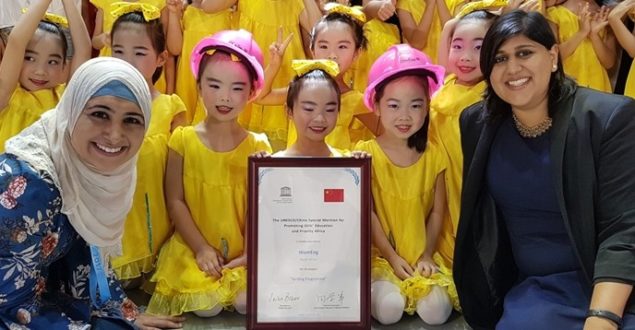14.10.2017/ By: en.unesco.org.
Limited female role models, misconceptions about engineering studies and careers, and gender bias and stereotypes are some of the factors that are keeping girls and women out of engineering studies and careers. Why should we care?
“Only 11% of all engineers globally are female,” shares Naadiya Moosajee, co-founder of WomEng, a South African social enterprise now operating in 13 countries. “Engineers design our world and our society, and if we don’t have women at the design table, we exclude 50% of the population.”
Education pathways for girls and women into engineering are extremely limited, finds UNESCO’s recent report, Cracking the code: Girls’ and women’s education in STEM(link is external). According to UNESCO’s Institute of Statistics, only 8 percent of all students in engineering, manufacturing and construction globally are women.
Ensuring girls and women have equal access to STEM careers is an imperative from human rights, scientific and development perspectives. “It’s not just about the SDGs or social development, but it’s also an economic imperative to have more women going into engineering and technology,” explains Naadiya. Gender equality in STEM will ensure that boys and girls, men and women, will be able to contribute to, and benefit equally from, the benefits and assets associated with STEM.
The next generation of women engineers
WomEng has been working since 2006 to develop the next generation of women engineers and leaders. “I’m an engineer and so is my cofounder, Hema. For us, it’s deeply personal. We started this organization because our classes didn’t have anyone that looked like us,” says Naadiya. “We decided to do something to change the status quo.”
Over the last 12 years, WomEng has been “igniting the engineering flame” with female high students through the GirlEng programme which connects girls to mentors, role models, and practical exposure to engineering projects and careers. After ten years, “we had over 10,000 girls in the programme, and we were able to change mindsets around engineering and technology,” explains Naadiya, “In South Africa, we’ve seen shifts in the number of students applying to study engineering. Our classes have gone from 10% to 30-40% [female], depending on the engineering field. That’s in large part due to our GirlEng programme.”
GirlEng’s signature item is the pink hard hat. In GirlEng workshops, participants transform the hard hat, sharing what they hope to bring to the engineering sector and the world. “The whole symbolic meaning around this pink hard hat is that it’s universal – any person can become an engineer. It travels around the world…we also give the hard hats to the girls to go through this personal development exercise to show that everybody is different and engineering needs different people to create innovative solutions to meet the SDGs,” explains Naadiya.
UNESCO is collaborating with WomEng on the One Million Girls in STEM campaign(link is external), launched together at the UN Commission on the Status of Women in March this year. The campaign aims to reach 1 million girls through STEM education and awareness initiatives in at least 10 different countries over the next 10 years. WomEng was also recently awarded the UNESCO/China Special Mention for Promoting Girls’ Education and Priority Africa at the BRICS Summit in China.
When asked what she would say to a six year old girl thinking about a future in engineering, Naadiya concluded, “I would say go and do [it], because that’s where the future lies and we need more engineers to create a better world… I would say go for it, because the sky isn’t even the limit because as an engineer you get to build rocketships.”
From: http://en.unesco.org/news/womeng-south-africa-cracking-code-get-girls-engineering-studies






 Users Today : 148
Users Today : 148 Total Users : 35459743
Total Users : 35459743 Views Today : 255
Views Today : 255 Total views : 3418227
Total views : 3418227